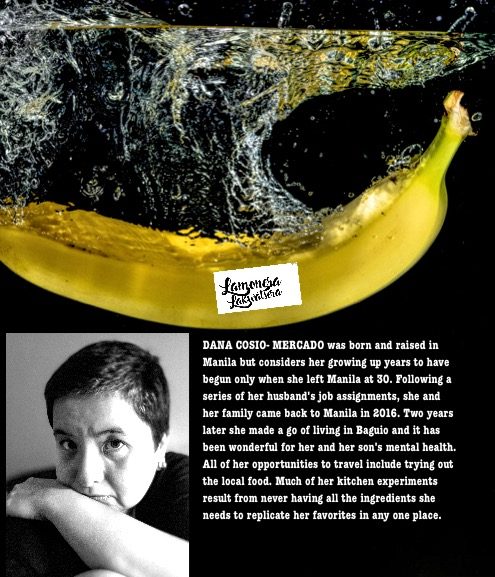By Dana Cosio-Mercado
“HIJA, sit here. I will teach you Math,” Lolo Alfred pointed to an empty chair at a square table. The other three seats were occupied by 60-something-year-olds, and thus did I find myself surrounded by four elders, all somehow related to my maternal grandfather at Lolo Alfred’s home on a Sunday afternoon, picking up the basics of a beloved parlor game.
Lolo Alfred was my grandfather’s brother-in-law. But to my eight-year-old eyes, there was no distinction between blood relations and in-laws and no awareness of family history. It wasn’t till much later that I made out the connections, and learned the details of the family story that the elders used to live close to each other in old San Juan and used to gather regularly to play poker or canasta well before the war that turned their lives upside down.
On that afternoon, I learned the rules of the game, and was entrusted with a small stack of coins to play against grand uncles and grand aunts, Lolo Alfred all the while seated behind me, whispering only the principles of the game but leaving me to strategize, and cackling loudly as I won one round after another. I was careful and deliberate because it wasn’t my money and I was afraid to lose it all. I might have had some uncounted coins in my little pink porcelain piggy bank at home but I was sure it didn’t amount to the coins at the corner of the table and changing hands after each game.
He let me keep my winnings, it was a point of pride for him that he was able to pick out the grandniece who was most likely to learn and earn for him. I don’t recall the amount, somewhere between 10 and 15 pesos, definitely a huge sum for my 1979 self. Or at least, huge enough to hook me to the game. But obviously a pittance for Lolo Alfred.
Over the years, my maternal grandparents would also have a table set up in their living room where we would gather after homework had been done but well before dinner. Afternoons were hot and lazy, and there would always be some combination of grandparent, parent, uncle, aunt, or cousin at that table with me. There were favored players, who were quick and decisive, and there were eager players who we just had to tolerate, egging us on to make their play with “This isn’t chess, don’t take too much time! Just throw a tile, <<any>> tile already!”
The game of this branch of the family was never as high stakes as Lolo Alfred’s table. In mahjong, as in life, this branch liked to keep things low-key and safe. We played with poker chips, each seat being assigned a lot of 100. At the end of the day, which meant whenever Lola became tired and ready for her dinner, we settled accounts and declared a winner. I don’t recall how the rule started but whoever won the most poker chips had to treat the rest of the players to pizza. It was fun to win in poker chips but it didn’t translate to anything you could keep long term, and you better have been in the mood for pizza at that moment, because that was all we ever shared as a common prize. It was a nice treat in the mid-80s, but I have to wonder now if any of the family members ever learned anything about calculating risk or, indeed, living within one’s means when losing at a game simply meant you could keep asking the banker for more chips from a kitty that seemed to be bottomless. Losing in poker chips certainly didn’t extend into any lifelong lessons, and winners and losers all partook of the same pie.
As an older teenager and making the rounds of college friends, I eventually discovered that many people also had their own mahjong stories to tell. What was universal is that the game was learned among family, most often with elders who needed a fourth player. What was not constant was whether it was first picked up with the money involved. What was even more unusual was our arrangement of those who had more being expected to fork over for the meal of those who didn’t have anything. Perhaps in life, yes. But it wasn’t always the mahjong rule of choice in other families.
As my own little family of four moved around, I encountered a variety of mahjong groups, each with its rules, each its ways of doing things. There was the group of unemployed-by-circumstance trailing spouses, two of us were female and three were male, and in our group of five, we would take turns sitting out one game so the other four could play, the arrangement happening with as much ease as one of us would take on child minding tasks for someone else who needed to see a doctor or a relative or the inside of a shopping center without kids in tow.
There was the very steady weekly mahjong group of Filipino families in another country, some the trailing spouses and some the reassigned employees themselves needing a break from the drudgery of corporate work. Often there would be some form of homemade Filipino merienda to ease the homesickness in the colder months. Always, we would discover differences in the way the game was played in our childhood homes, and we ended up with a mishmash of styles which in the end defied a proper label.
There was the very unusual and highly uninteresting (to me) mahjong club of school moms. We would always have enough players for 3-5 tables and the ones with lots of experience had to sit and teach newbies. But the buzzkill for me was a booklet of 200 or so different combinations of “special hands” that the players were supposed to pattern their winning tiles after. I tried for two afternoons then dropped out, it was so removed from the hybrid Filipino-Chinese style I learned. Some hands had suspiciously-Chinese sounding names, like “Three Great Scholars” but “Gathering the Plum Blossom from the Tiled Roof” sounded more like a martial arts movie title to me than a mahjong combo.
A quick, dictionary-aided conversation with our Chinese drivers confirmed that these were indeed British adaptations of the HongKong version of the game, and were far removed from the more traditional Beijing style that had many similarities to our Filipino style. (Traditional Beijing was not to be confused with other regional Chinese versions, one of the baffling ones being a game where the discards are placed face down so that the other players don’t even know what has been disposed of.) Looking back, it is not entirely surprising that colonizers would tweak a local game to make it more interesting to their sensibilities. The Filipino version I grew up with (in itself just one of many different formats) had its own adjustments from the original, too.
Once in a while, a group of lady friends will gather in Baguio for the game. It is not the only thing we share in common. In fact, we are more likely to take turns eating at a restaurant owned by one of the ladies in the group, or grabbing a quick coffee in the middle of the busy week just to keep in touch and ask about each other’s husband/kids/dog/cat. Mahjong is just another outlet and excuse to get together, and while we are all capable players, it has not taken on any kind of regularity in our Baguio days.
Yesterday, I played for a few hours with a group of college friends. We have had several instances of playing together over the years, each in different phases of our lives. As varied as the versions of the games that I have encountered have been, so too have the versions of the same players changed. We first played together at 18, then as 20-and 30-somethings, and yesterday as 50-or-so year olds. It was our first game in a long time, also the first time we reunited since one in the group had a stroke two years ago. Talk was different but talk came easy, as they do if you are lucky to be among old friends. Perhaps our quiet pauses brought us back to our childhood selves or even just to our college selves. But the steady banter also kept us rooted in the present, playing the game, sometimes forgetting the right ways, bending the rules when someone made a big mistake, raising the stakes for a bit of fun, singing aloud to old music, paying each other with plastic chips, taking a break for pizza or medication. In a rather amusing world-is-small moment, I am suddenly remembering that one of yesterday’s group herself, as a teenager, met and did stage plays with <<my>> Lolo Alfred.
We are slowly creeping up to the age of Lolo Alfred and the relatives who first taught us, and we probably now sound like them in those early days too. And as we move on in years, we can only hope that we take with us the best of our beloved game and the life lessons our elders have passed down to us. There will always be something new to learn.




There are no comments yet. Add your comment to start the conversation.